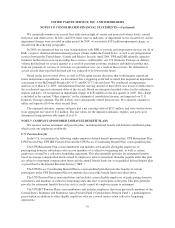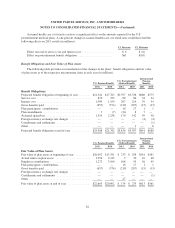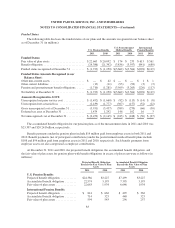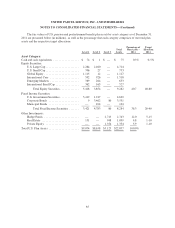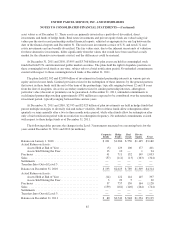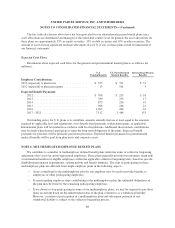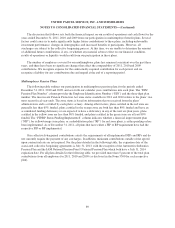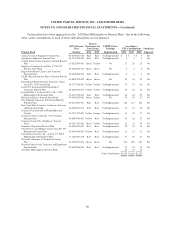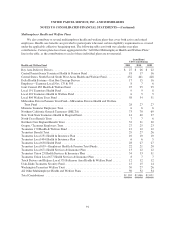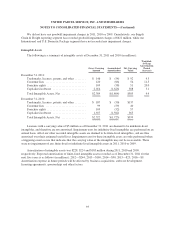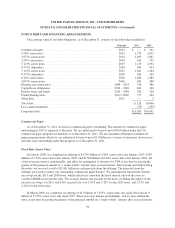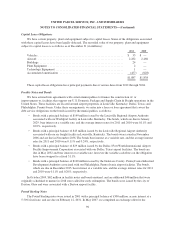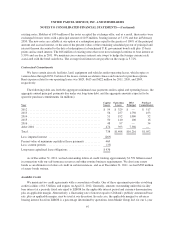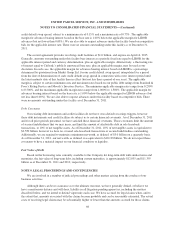UPS 2011 Annual Report Download - page 100
Download and view the complete annual report
Please find page 100 of the 2011 UPS annual report below. You can navigate through the pages in the report by either clicking on the pages listed below, or by using the keyword search tool below to find specific information within the annual report.
UNITED PARCEL SERVICE, INC. AND SUBSIDIARIES
NOTES TO CONSOLIDATED FINANCIAL STATEMENTS—(Continued)
The fair value disclosures above have not been provided for our international pension benefit plans since
asset allocations are determined and managed at the individual country level. In general, the asset allocations for
these plans are approximately 55% in equity securities, 35% in debt securities and 10% in other securities. The
amount of assets having significant unobservable inputs (Level 3), if any, in these plans would be immaterial to
our financial statements.
Expected Cash Flows
Information about expected cash flows for the pension and postretirement benefit plans is as follows (in
millions):
U.S.
Pension Benefits
U.S. Postretirement
Medical Benefits
International Pension
Benefits
Employer Contributions:
2012 (expected) to plan trusts ..................... $ 355 $ 371 $ 53
2012 (expected) to plan participants ................ 13 101 3
Expected Benefit Payments:
2012 ..................................... $ 708 $ 233 $ 18
2013 ..................................... 789 253 17
2014 ..................................... 873 230 19
2015 ..................................... 966 246 21
2016 ..................................... 1,065 260 23
2017 - 2021 ............................... 7,112 1,466 153
Our funding policy for U.S. plans is to contribute amounts annually that are at least equal to the amounts
required by applicable laws and regulations, or to directly fund payments to plan participants, as applicable.
International plans will be funded in accordance with local regulations. Additional discretionary contributions
may be made when deemed appropriate to meet the long-term obligations of the plans. Expected benefit
payments for pensions will be primarily paid from plan trusts. Expected benefit payments for postretirement
medical benefits will be paid from plan trusts and corporate assets.
NOTE 6. MULTIEMPLOYER EMPLOYEE BENEFIT PLANS
We contribute to a number of multiemployer defined benefit plans under the terms of collective bargaining
agreements that cover our union-represented employees. These plans generally provide for retirement, death and/
or termination benefits for eligible employees within the applicable collective bargaining units, based on specific
eligibility/participation requirements, vesting periods and benefit formulas. The risks of participating in these
multiemployer plans are different from single-employer plans in the following aspects:
• Assets contributed to the multiemployer plan by one employer may be used to provide benefits to
employees of other participating employers.
• If a participating employer stops contributing to the multiemployer plan, the unfunded obligations of
the plan may be borne by the remaining participating employers.
• If we choose to stop participating in some of our multiemployer plans, we may be required to pay those
plans an amount based on the underfunded status of the plan, referred to as a withdrawal liability.
However, cessation of participation in a multiemployer plan and subsequent payment of any
withdrawal liability is subject to the collective bargaining process.
88



